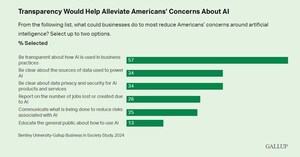WALTHAM, Mass., Oct. 20, 2021 /PRNewswire/ -- Inclusion for employees with disabilities is becoming a priority at Fortune 500 companies, start-ups, non-profits and academic institutions — but organizations often fail to leverage the talents of workers with disabilities, according to a report from Bentley University's Center for Women and Business (CWB). As the nation marks National Disability Employment Awareness Month the report, Inclusion for Disability, Mental Health, and Wellbeing in the Workplace , highlights relevant research and interviews with thought leaders, employees, and executives engaged in disability inclusion and presents strategies to nurture disability inclusion.
"More than a quarter of all people in the U.S. have a disability, and organizations leading in disability inclusion can leverage a larger talent pool and create new avenues for innovation and profitability," says report author and CWB Advisor Trish Foster. "Yet only 31 percent of people with disabilities in the U.S. are employed compared to 75 percent of people without disabilities."
Most disabilities – about 62 percent – are invisible, making it harder for employees to disclose and seek accommodations. Common unseen disabilities include autism spectrum disorder, diabetes, ADHD, dyslexia, learning differences, memory issues, chronic pain or fatigue, and disabilities related to mental health.
Barriers to Supporting Employees with Disabilities
According to the report, more than two-thirds of leaders believe their technological arrangements and cultures are supportive of disabled employees, but less than half of those with disabilities agree. Navigating work with an invisible disability such as mental health presents specific challenges, partly because of public fear and stigma.
Some reasons why companies don't leverage talent, according to the American Association of People with Disabilities and Disability:IN, are based on a lack of understanding. Employers often underestimate the depth of the available talent pool and the potential benefits people with disabilities bring to the workplace. Businesses also misconstrue the cost versus the return on investment for disability inclusion, yet 59 percent of accommodations cost nothing to make, and the rest typically cost less than $500 per employee with a disability.
"Disability inclusion is worth the investment," Foster says. "Data shows that organizations working actively to employ and support people with disabilities outperform peers across an array of metrics such as higher shareholder returns, more inclusive products and services going to market and lower voluntary turnover rates."
Workplace discrimination for people with disabilities includes wage gaps, despite the passage of legislation prohibiting pay discrimination over 30 years ago. Foster says there are specific barriers for people with intersecting identities. These include:
- Women and mothers face significant mental health pressures, with Black, Hispanic and single mothers being impacted the most
- People of color confront long-term structural inequalities that impact mental health
- Disabled people who identify as LGBTQ+ report higher rates of unemployment than others
Best Practices to Nurture Disability Inclusion
Today's workforce expects organizations to create inclusive environments for all employees, including those with disabilities. "Many strategies useful for other underrepresented groups can help with disability inclusion, yet there are interventions unique to this community, too," Foster says. "Employers must commit to expanding the scope of accommodations, creating transparency and reducing stigma, and adopting new strategies to recruit and promote people with disabilities."
The report provides numerous recommendations to help organizations, leaders and allies nurture disability inclusion, including:
- Addressing unique needs for people of color who are disabled
- Mainstreaming universal design to promote better access for everyone – disabled and non-disabled people alike
- Using metrics to measure success and ensure accountability
- Leveraging employee resource groups (ERGs) where people with disabilities and their advocates can openly discuss issues
- Practicing everyday allyship
- Becoming knowledgeable about language choice
- Addressing the role of artificial intelligence (AI)
Younger workers are impacting the mental health landscape and helping to change attitudes and approaches toward disability in the workplace.
"Up to 75 percent of Generation Z workers have left jobs at least partly because of mental health, but the upside is that current data indicates that employees are more likely to seek help with stress, anxiety, and depression than they were as recently as five years ago."
Leaders who disclose a disability serve as positive role models and can act as catalysts for change and mentor others.
"More than half of CEOs believe talking about their own mental health makes them a better leader, yet they hold back largely because of concerns it will impact their credibility and employee confidence in them," Foster says. "If bosses aren't speaking out about inclusion, if accommodations aren't being made and if employees don't feel they can raise concerns about how they're treated, then secrecy reigns and employees and organizations can't reach their potential."
SOURCE Bentley University

WANT YOUR COMPANY'S NEWS FEATURED ON PRNEWSWIRE.COM?
Newsrooms &
Influencers
Digital Media
Outlets
Journalists
Opted In






Share this article